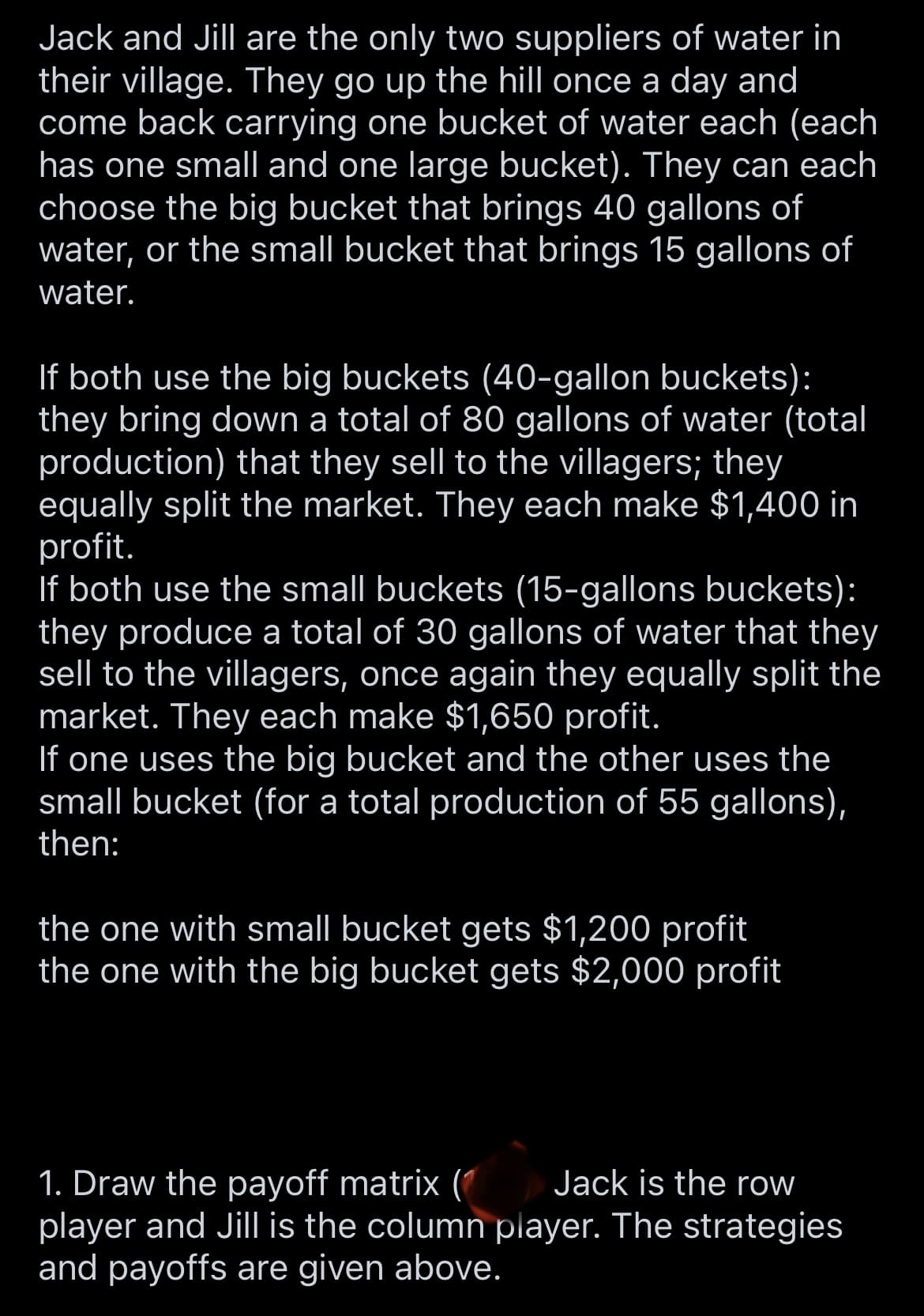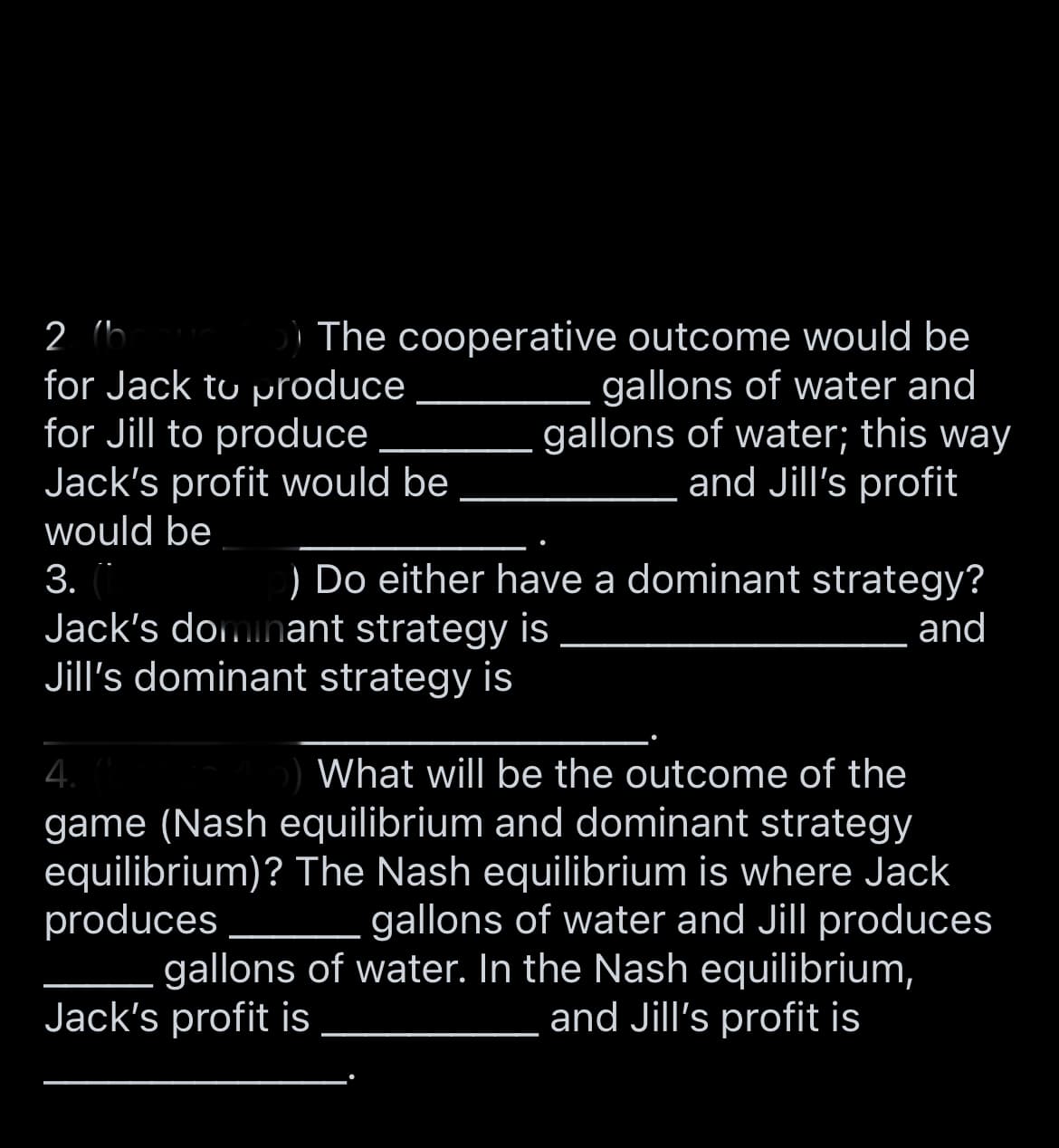Jack and Jill are the only two suppliers of water in their village. They go up the hill once a day and come back carrying one bucket of water each (each has one small and one large bucket). They can each choose the big bucket that brings 40 gallons of water, or the small bucket that brings 15 gallons of water.
Jack and Jill are the only two suppliers of water in their village. They go up the hill once a day and come back carrying one bucket of water each (each has one small and one large bucket). They can each choose the big bucket that brings 40 gallons of water, or the small bucket that brings 15 gallons of water.
Managerial Economics: Applications, Strategies and Tactics (MindTap Course List)
14th Edition
ISBN:9781305506381
Author:James R. McGuigan, R. Charles Moyer, Frederick H.deB. Harris
Publisher:James R. McGuigan, R. Charles Moyer, Frederick H.deB. Harris
Chapter12: Price And Output Determination: Oligopoly
Section: Chapter Questions
Problem 1E
Related questions
Question

Transcribed Image Text:Jack and Jill are the only two suppliers of water in
their village. They go up the hill once a day and
come back carrying one bucket of water each (each
has one small and one large bucket). They can each
choose the big bucket that brings 40 gallons of
water, or the small bucket that brings 15 gallons of
water.
If both use the big buckets (40-gallon buckets):
they bring down a total of 80 gallons of water (total
production) that they sell to the villagers; they
equally split the market. They each make $1,400 in
profit.
If both use the small buckets (15-gallons buckets):
they produce a total of 30 gallons of water that they
sell to the villagers, once again they equally split the
market. They each make $1,650 profit.
If one uses the big bucket and the other uses the
small bucket (for a total production of 55 gallons),
then:
the one with small bucket gets $1,200 profit
the one with the big bucket gets $2,000 profit
Jack is the row
1. Draw the payoff matrix (1
player and Jill is the column player. The strategies
and payoffs are given above.

Transcribed Image Text:2 (b
for Jack to produce
for Jill to produce
Jack's profit would be
The cooperative outcome would be
gallons of water and
gallons of water; this way
and Jill's profit
would be
3.
) Do either have a dominant strategy?
Jack's doinant strategy is
Jill's dominant strategy is
and
4.
game (Nash equilibrium and dominant strategy
equilibrium)? The Nash equilibrium is where Jack
produces
gallons of water. In the Nash equilibrium,
Jack's profit is
What will be the outcome of the
gallons of water and Jill produces
and Jill's profit is
Expert Solution
This question has been solved!
Explore an expertly crafted, step-by-step solution for a thorough understanding of key concepts.
This is a popular solution!
Trending now
This is a popular solution!
Step by step
Solved in 4 steps with 3 images

Knowledge Booster
Learn more about
Need a deep-dive on the concept behind this application? Look no further. Learn more about this topic, economics and related others by exploring similar questions and additional content below.Recommended textbooks for you

Managerial Economics: Applications, Strategies an…
Economics
ISBN:
9781305506381
Author:
James R. McGuigan, R. Charles Moyer, Frederick H.deB. Harris
Publisher:
Cengage Learning


Managerial Economics: Applications, Strategies an…
Economics
ISBN:
9781305506381
Author:
James R. McGuigan, R. Charles Moyer, Frederick H.deB. Harris
Publisher:
Cengage Learning
